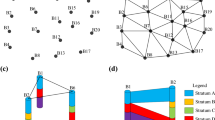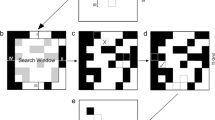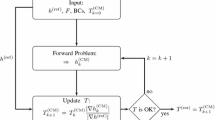Abstract
Suitable training images (TIs) for multiple-point statistics (MPS) are difficult to identify in real-case three-dimensional applications, posing challenges for modelers trying to develop realistic subsurface models. This study demonstrates that two-dimensional geophysical images, when employed as training and conditioning data, can provide sufficient information for three-dimensional MPS simulations. The advantage of such a data-driven approach is that it does not rely on any external (possibly inappropriate) TI. The disadvantage is that three-dimensional MPS simulations must be carried out based on two-dimensional information. Three different approaches (two existing, one new) are tested to overcome this problem. The two existing approaches rely on three-dimensional reconstruction of incomplete datasets and on sequential two-dimensional simulations, respectively. The third approach is a newly proposed combination of the two former approaches. The three approaches are applied to model the three-dimensional facies structure of an alluvial aquifer based on high-resolution ground-penetrating radar cross-sections. The quality of each simulation outcome is evaluated based on the similarity of its multiple-point histogram (MPH) to reference MPHs derived from geophysical images. This evaluation reveals that the first approach (three-dimensional reconstruction) performs well close to conditioning data, but farther away from the data the simulation results deteriorate. Quite conversely, the second approach (sequential two-dimensional) performs well when only few conditioning data exist, but with increasing simulation sequence the quality decreases. The newly proposed third approach integrates the benefits of both approaches and is found to reproduce the reference MPHs significantly better than either of the two other approaches alone.















Similar content being viewed by others
References
Bayer P, Huggenberger P, Renard P, Comunian A (2011) Three-dimensional high resolution fluvio-glacial aquifer analog: part 1: field study. J Hydrol 405(1–2):1–9
Bayer P, Comunian A, Höyng D, Mariethoz G (2015) High resolution multi-facies realizations of sedimentary reservoir and aquifer analogs. Sci Data 2:150033
Boisvert JB, Pyrcz MJ, Deutsch CV (2007) Multiple-point statistics for training image selection. Nat Resour Res 16(4):313–321
Caers J (2011) Modeling uncertainty in the earth sciences. Wiley, Hoboken
Comunian A, Renard P (2008) Introducing wwhypda: a world-wide collaborative hydrogeological parameters database. Hydrogeol J 17(2):481–489
Comunian A, Renard P, Straubhaar J (2012) 3D multiple-point statistics simulation using 2D training images. Comput Geosci 40:49–65
Comunian A, Jha SK, Giambastiani BMS, Mariethoz G, Kelly BFJ (2013) Training images from process-imitating methods. Math Geosci 46(2):241–260
Deutsch C, Journel A (1998) GSLIB: geostatistical software library and users guide, 2nd edn. Oxford University Press, Oxford
Englert A (2003) Measurement, estimation and modelling of groundwater flow velocity at Krauthausen test site. Dissertation, RWTH Aachen
Gómez-Hernández JJ, Wen Xh (1998) To be or not to be multi-Gaussian? A reflection on stochastic hydrogeology. Adv Water Resour 21(1):47–61
Guardiano FB, Srivastava RM (1993) Multivariate geostatistics: beyond bivariate moments. In: Soares A (ed) Geostatistics Tróia ’92, vol 1. Springer, Dordrecht, pp 133–144
Gueting N, Klotzsche A, van der Kruk J, Vanderborght J, Vereecken H, Englert A (2015) Imaging and characterization of facies heterogeneity in an alluvial aquifer using GPR full-waveform inversion and cone penetration tests. J Hydrol 524:680–695
Gueting N, Vienken T, Klotzsche A, van der Kruk J, Vanderborght J, Caers J, Vereecken H, Englert A (2017) High resolution aquifer characterization using crosshole GPR full-waveform tomography: comparison with direct-push and tracer test data. Water Resour Res. doi:10.1002/2016WR019498
Hermans T, Nguyen F, Caers J (2015) Uncertainty in training-image based inversion of hydraulic head data constrained to ERT data: workflow and case study. Water Resour Res 51:5332–5352
Huysmans M, Dassargues A (2009) Application of multiple-point geostatistics on modelling groundwater flow and transport in a cross-bedded aquifer (Belgium). Hydrogeol J 17(8):1901–1911
Huysmans M, Dassargues A (2012) Modeling the effect of clay drapes on pumping test response in a cross-bedded aquifer using multiple-point geostatistics. J Hydrol 450–451:159–167
Kessler T, Comunian A, Oriani F (2013) Modeling fine-scale geological heterogeneity-examples of sand lenses in tills. Ground Water 51(5):692–705
Klotzsche A, van der Kruk J, Meles GA, Doetsch J, Maurer H, Linde N (2010) Full-waveform inversion of cross-hole ground-penetrating radar data to characterize a gravel aquifer close to the Thur River, Switzerland. Near Surf Geophys 8:635–649
Klotzsche A, van der Kruk J, Linde N, Doetsch J, Vereecken H (2013) 3-D characterization of high-permeability zones in a gravel aquifer using 2-D crosshole GPR full-waveform inversion and waveguide detection. Geophys J Int 195(2):932–944
Le Coz M, Genthon P, Adler PM (2011) Multiple-point statistics for modeling facies heterogeneities in a porous medium: the Komadugu-Yobe Alluvium, Lake Chad Basin. Math Geosci 43(7):861
Li W, Englert A, Cirpka OA, Vanderborght J, Vereecken H (2007) Two-dimensional characterization of hydraulic heterogeneity by multiple pumping tests. Water Resour Res. doi:10.1029/2006WR005333
Li W, Englert A, Cirpka OA, Vereecken H (2008) Three-dimensional geostatistical inversion of flowmeter and pumping test data. Ground Water 46(2):193–201
Maharaja A (2008) TiGenerator: object-based training image generator. Comput Geosci 34(12):1753–1761
Mariethoz G, Caers J (2014) Multiple-point geostatistics: stochastic modeling with training images. Wiley-Blackwell, Hoboken
Mariethoz G, Renard P (2010) Reconstruction of incomplete data sets or images using direct sampling. Math Geosci 42(3):245–268
Mariethoz G, Renard P, Straubhaar J (2010) The direct sampling method to perform multiple-point geostatistical simulations. Water Resour Res. doi:10.1029/2008WR007621
Müller K, Vanderborght J, Englert A, Kemna A, Huisman JA, Rings J, Vereecken H (2010) Imaging and characterization of solute transport during two tracer tests in a shallow aquifer using electrical resistivity tomography and multilevel groundwater samplers. Water Resour Res. doi:10.1029/2008WR007595
Ortiz JM, Deutsch CV (2004) Indicator simulation accounting for multiple-point statistics. Math Geol 36(5):545–565
Pickel A, Frechette JD, Comunian A, Weissmann GS (2015) Building a training image with Digital Outcrop Models. J Hydrol 531:53–61
Renard P, Allard D (2013) Connectivity metrics for subsurface flow and transport. Adv Water Resour 51:168–196
Straubhaar J, Renard P, Mariethoz G, Froidevaux R, Besson O (2011) An improved parallel multiple-point algorithm using a list approach. Math Geosci 43(3):305–328
Strebelle S (2002) Conditional simulation of complex geological structures using multiple-point statistics. Math Geol 34(1):1–22
Tan X, Tahmasebi P, Caers J (2014) Comparing training-image based algorithms using an analysis of distance. Math Geosci 46(2):149–169
Vereecken H, Döring U, Hardelauf H, Jaekel U, Hashagen U, Neuendorf O, Schwarze H, Seidemann R (2000) Analysis of solute transport in a heterogeneous aquifer: the Krauthausen field experiment. J Contam Hydrol 45:329–358
Western AW, Böschl G, Grayson RB (2001) Toward capturing hydrologically significant connectivity in spatial patterns. Water Resour Res 37(1):83–97
Acknowledgements
This work was supported in part by the TERrestrial ENvironmental Observatories (TERENO) and in part by the Transregional Collaborative Research Centre 32 (TR32) Patterns in Soil–Vegetation–Atmosphere Systems: Monitoring, Modelling, and Data Assimilation. The authors wish to thank Philippe Renard, Julien Straubhaar, and Gregoire Mariethoz for fruitful discussions and for providing the MPS algorithms impala and direct sampling. We also wish to thank two anonymous reviewers for their valuable suggestions.
Author information
Authors and Affiliations
Corresponding author
Rights and permissions
About this article
Cite this article
Gueting, N., Caers, J., Comunian, A. et al. Reconstruction of Three-Dimensional Aquifer Heterogeneity from Two-Dimensional Geophysical Data. Math Geosci 50, 53–75 (2018). https://doi.org/10.1007/s11004-017-9694-x
Received:
Accepted:
Published:
Issue Date:
DOI: https://doi.org/10.1007/s11004-017-9694-x




